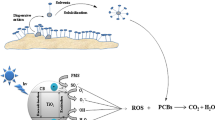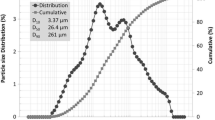Abstract
This paper reports the results of the treatment of polychlorinatedbiphenyl (PCB) contaminated sandy soils (100 mg kg-1 Aroclor 1242) with the Fenton advanced oxidation process (AOP). The results obtained in the various assays permitted the optimization of conditions as follows: 5% H2O2; 100 ppm of Fe3+; and a ratio of sandy soil mass/volume of oxidizing solution (m/V) of 1/3 g mL-1. In addition, these tests established the need for agitation and dispensed with the need for heat. The results obtained confirm that the oxidation process occurs in solid phase (on the PCBs adsorbed to soil particles), producing 98% elimination of the original PCB structure and 82% dechlorination, all within a reaction time of 72 hr. The degree of elimination was found to be dependent on the level of congener chlorination and the process displays a pseudo first order kinetics. In addition, the Fenton chemical oxidation process may be complemented by subsequent aerobic biological degradation which, after 15 days, produces 72% mineralization of the products generated during the chemical oxidation process.
Similar content being viewed by others
References
Amarante, D.: 2000, ‘Applying in situ chemical oxidation’, Pollut. Eng. 32, 40-42.
Bandara, J., Herrera, F., Kiwi, J. and Pulgarin, C.: 1998, ‘Degradation of concentrated solutions of non-biodegradable orange II by photocatalytic and electrochemical methods’, J. Chem. Res.(M), 1153-1172.
Barriault, D. and Sylvestre, M.: 1993, ‘Factors affecting PCB degradation by an implanted bacterial strain in soil microcosm’, Can. J. Microbiol. 39, 594-602.
Bishop, D. F., Stern, G. F., Fleishman, M. and Marshall, L. S.: 1968, ‘Hydrogen peroxide catalytic oxidation of refractory organics in municipal wastewater’, Ind. Eng. Chem. Process Develop. 7, 110-115.
Furakawa, K.: 1982, Microbial Degradation of Polychlorinated Biphenyl (PCBs). Biodegradation and Detoxification of Environmental Pollutants, A. M. Chakrabarty, CRC Press, Boca Ratón, Florida.
Gates, D. D. and Siegrist, R. L.: 1995, ‘In-situ chemical oxidation of trichloroethylene using hydrogen peroxide’, J. Env. Eng. September, 639-644.
Kang, Y. W. and Hwang, K.: 2000, ‘Effects of reaction conditions on the oxidation efficiency in the Fenton process’, Water Res. 34, 2786-2790.
Li, Z. M., Comfort, S. D. and Shea, P. J.: 1997, ‘Destruction of 2,4,6-Trinitrotoluene by Fenton oxidation’, J. Env.Qual. 26, 480-487.
Lipezynska-Kochany, E.: 1991, ‘Degradation of aqueous nitrophenols and nitrobenzene by means of the Fenton reactions’, Chemosphere 22, 529-535.
Ofjord, G. D., Puhakka, J. A. and Ferguson, J. F.: 1994, ‘Reductive dechlorination of Aroclor 1254 by marine sediment cultures’, Environ. Sci. Technol. 28(13), 2286-2294.
Osman, A.: 1985, ‘Re-assessment of the titration method for determination of organic carbon in recent sediments’, Rapp. Com. Int. Mer. Méd. 29(7), 45-47.
Pignatello, J. J. and Chapa, G.: 1994, ‘Degradation of PCBs by ferric ion, hydrogen peroxide and light’, Environ. Toxicol. Chem. 13(3), 423-427.
Quensen, J. F., Boyd, S. A. and Tiedje, J. M.: 1990, ‘Dechlorination of four commercial polychlorinated biphenyl mixtures (Aroclors) by anaerobic microorganisms from sediments’, Appl. Environ. Microbiol. 56(8), 2360-2369.
Ravikumar J. X. and Gurol, M. D.: 1994, ‘Chemical oxidation of chlorinated organics by hydrogen peroxide in the presence of sand’, Environ. Sci. Technol. 28(3), 394-400.
Sedlak, D. L. and Andren, A. W.: 1991, ‘Aqueous-phase oxidation of PCBs by hydroxyl radicals’, Environ. Sci. Technol. 25(8), 1419-1426.
Sedlak, D. L. and Andren, A. W.: 1994, ‘The effect of sorption on the oxidation of polychlorinated biphenyls (PCBs) by hydroxyl radicals’, Water Res. 28(8), 1207-1215.
APHA-AWWA-WPFC: 1989, ‘Standard Methods for the Examination of Water and Wastewater’.
Watts, R. J. and Dilly, S. E.: 1996, ‘Evaluation of iron catalyst for the Fenton-like remediation of diesel-contaminated soils’, J. Hazard. Mat. 51, 209-224.
Watts, R. J., Udell, M. D. and Monsen, R. M.: 1993, ‘Use of iron minerals in optimizing the peroxide treatment of contaminated soils’, Water Environ. Res. 65, 839-845.
Watts, R. J., Udell, M. D. and Rauch, P. A.: 1990’ ‘Treatment of PCP-contaminated soil using Fenton's reagent’, Hazard. Waste and Hazard. Manag. 7(4), 335-345.
Weber, A. S.: 1996, Personal Comunication, New York Centre for Hazardous Waste Management, State University of New York at Buffalo, Civil Engineering Department, Buffalo, NY, 14260, U.S.A.
Winding, A., Binnerup, S. J. and Sorensen J.: 1994, ‘Viability of indigenous soil bacteria assayed by respiratory activity and growth’, Appl. Environ. Microbiol. 60(8), 2869-2875.
Yeh, C. K. and Novak, J. T.: 1995, ‘The effect of hydrogen peroxide on the degradation of methyl and ethyl tert-butyl ether in soils’, Water Environ. Res. 67(5), 221-229.
Author information
Authors and Affiliations
Rights and permissions
About this article
Cite this article
Manzano, M.A., Perales, J.A., Sales, D. et al. Catalyzed Hydrogen Peroxide Treatment of Polychlorinated Biphenyl Contaminated Sandy Soils. Water, Air, & Soil Pollution 154, 57–69 (2004). https://doi.org/10.1023/B:WATE.0000022931.58418.90
Issue Date:
DOI: https://doi.org/10.1023/B:WATE.0000022931.58418.90




